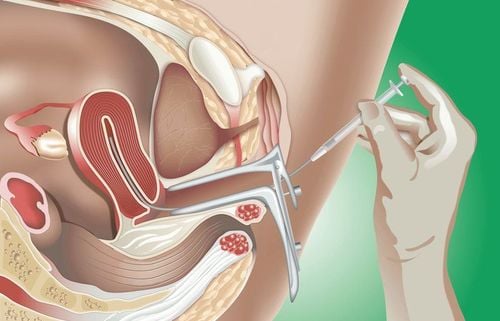This is an automatically translated article.
Fetal underdevelopment in the uterus is one of the challenging problems for obstetricians. Ultrasound is a safe imaging method, helping to assess fetal growth disorders accurately and quickly.
1. Fetal growth disorder
Intrauterine underdevelopment or intrauterine growth restriction is a nutritional deficiency that occurs to the fetus from infancy. If not intervened at the right time, the fetus is at risk of dying or making the child mentally retarded later on.
Fetal growth disorder is a condition in which fetal growth is delayed in utero, when the fetal weight is below the 10th percentile for gestational age on ultrasound. Causes of fetal growth disorder include:
Causes of pregnant women: Having medical diseases such as kidney, cardiovascular, hematologic, endocrine,... Or antiphospholipid syndrome , alcoholism, smoking, nutritional deficiencies,... Causes from fetal appendages: Diseases from the umbilical cord, placenta,... Fetal causes: Genetic disorders, fetal infection , multiple pregnancy,...
2. Screening for growth disorders in the fetus
Screening for fetal growth disorders should be based on history, biometric and biochemical data.
History of growth disorder is one of the important factors for pregnant women, posing a 2-3 times higher risk; The height of the mother's uterus should be measured at each visit. Uterine height usually approximates the number of weeks of gestation after the 20th week of pregnancy; Fetal growth and size were assessed by fetal parameters on ultrasound; The maternal serum AFP level is a suitable biochemical marker. When the AFP test index is high, the risk of growth disorders in the fetus increases 5-10 times.

Rối loạn tăng trưởng của thai nhi là tình trạng thai chậm phát triển trong tử cung
3. Ultrasound assessment of fetal growth disorders
3.1 Fetal size ultrasound Fetal ultrasound measures fetal size and weight and clinical manifestations can assess and manage fetal underdevelopment. Through ultrasounds, the doctor will draw a growth chart of those values and diagnose abnormalities, the risk of fetal growth disorders.
2.1.1 Butthead Length
The most accurate measurement of buttock length is between the 6th and 12th weeks of pregnancy. The maximum error of a certain gestational age is ± 5 days in 95% of cases. If the rump length falls outside the normal range, a chromosomal abnormality or morphological disorder should be suspected.
2.1.2 Biparietal Diameter
Biparietal diameter measured from 9th to 11th week of pregnancy. During ultrasound, it is important to note that the standard cross-section must cross the thalamus. Because if the lower cross section passes through the brain stem, it will lead to a condition where the gestational age is smaller than the actual age.
After the 14th to 28th week of pregnancy, biparietal diameter will be inaccurate due to conformational changes caused by growth disorders, which will greatly affect the size of the skull, increasing the error . If the skull is not of normal shape, the biparietal diameter should not be used, but head circumference should be used.
Clearly determine the gestational age and development of the fetus through two measurements 15 days apart. Intrauterine underdevelopment is divided into the following categories:
Partial asymmetrical underdevelopment: Occurs at the end of pregnancy. Indicators such as femur length and head circumference are normal or near-normal. In case the fetus is thin, the growth rate is horizontal and the waist circumference is smaller than normal: The fetus needs to be monitored for signs and symptoms of organ dysfunction, so that timely intervention can be made. time. This is common in pregnancies with impaired fetal perfusion. Total underdevelopment: Occurs early and is associated with a decrease in fetal cell count. A normal fetus will have a small size because of the genetic program. The measurements of biparietal diameter, waist circumference, and femoral length were all less than the 10th percentile. Along with that, the growth rate showed a normal curve. 2.2 Doppler ultrasound Doppler ultrasound, also known as color ultrasound, is a leading diagnostic technique that is widely applied today. The Doppler ultrasound technique uses continuous waves to detect the direction and velocity of flow within the body. Therefore, in obstetrics and gynecology, fetal Doppler ultrasound helps to examine, diagnose and evaluate the health of the fetus, has the effect of measuring the flow of blood vessels, surveying the fetal heart rate and a few other functions that these techniques cannot be used. Conventional fetal ultrasound cannot be performed. Doppler ultrasound helps to measure the impedance index of the umbilical artery, the middle cerebral artery in the fetus, and the uterine artery in the pregnant woman.
2.2.1 Middle cerebral artery and ductus venosus Doppler ultrasound of the middle cerebral artery and ductus venosus to examine the color flow. The heart and brain are supplied with oxygen- and nutrient-rich blood as a ductus venosus. Redistribution of oxygen-rich blood flow from the umbilical vein to the ductus venosus occurs when anemia and acidosis are severe.
Fetal doppler ultrasound has the function of checking necessary nutrients and oxygen flow, which cannot be done by conventional fetal ultrasounds. Doppler ultrasound can be performed in the last 3 months of pregnancy, or periodic antenatal check-ups at the request of the doctor, in order to evaluate and ensure that the fetus is developing comprehensively.
2.2.2 Uterine artery Doppler ultrasound The uterine artery plays a very important role, having the function of conducting blood to the uterus of the pregnant woman to provide oxygen and nutrients to the developing fetus. in the womb. So, a Doppler ultrasound of the uterine arteries will help the doctor check the blood supply to the placenta. If the placenta does not receive the required amount of blood, it means that the fetus cannot receive enough oxygen and nutrients through the umbilical cord.
Uterine artery Doppler ultrasound is only applicable in pregnant women with normal uterine anatomy, and no uterine congenital anomalies, can be performed with transabdominal or transvaginal transducers religion.
2.2.3 Umbilical artery Doppler ultrasound
The umbilical cord is the bridge from mother to baby to provide oxygen and nutrients. Umbilical artery doppler ultrasound checks the flow of blood from the placenta to the umbilicus. Cases in which the umbilical artery Doppler ultrasound method is indicated include:
Fetal growth retardation, other than small fetuses for gestational age; The fetus is affected by incompatible Rh antibodies in the blood; Pregnant women carrying multiples, identical twins, having a BMI that is too high or too low, or having other chronic diseases such as high blood pressure, diabetes,... Pregnant women with a history of low birth weight babies , miscarriage at a late stage, or infant death shortly after birth.

Qua những lần siêu âm, bác sĩ sẽ chẩn đoán được những bất thường, nguy cơ rối loạn tăng trưởng của thai nhi
3. Direction of diagnosis of fetal growth disorder
To diagnose fetal growth disorder should be based on changes in clinical and laboratory signs. In addition, the severity of fetal underdevelopment through ultrasound and Doppler results occurs in 2 cases:
If the pregnant woman has no medical history: The pregnancy progresses normally. If the fetal size and weight are smaller than the gestational age, it is likely that the gestational age is incorrect or the fetus is small due to genetics, before the diagnosis of intrauterine growth disorder is diagnosed. Pregnant women have a chronic medical condition before pregnancy: For example, chronic high blood pressure, renal vascular disease, diabetes or possibly a complication of pregnancy such as infection, recurrent bleeding development in the last 2 trimesters, multiple pregnancy. Or it may be due to a pre-existing or environmental factor such as smoking, drug addiction, malnutrition, ... have ever given birth to a child with a growth disorder, or the fetus died in labor not due to difficult delivery. . These subjects should undergo Doppler ultrasound screening of the uterine artery, umbilical artery or middle cerebral artery at 18-22 weeks. Ultrasound assesses fetal development from the end of the second trimester and the beginning of the third trimester of pregnancy and repeats after 2 weeks. In summary, ultrasound assessment of fetal growth disorders is a safe, non-invasive diagnostic method. Doppler ultrasound not only helps pregnant women prevent obstetric complications, but also assesses the development of the fetus in the womb, prevents the risk of malformations, perinatal death,... Therefore, the fetus Women need to have regular antenatal check-ups and when there are abnormal signs. In particular, the second 3 months of pregnancy is a period of strong fetal development. Pregnant women need:
Comprehensive fetal malformation screening by superior 4D ultrasound technique. Screening for gestational diabetes, avoiding many dangerous complications for both mother and baby. Control the mother's weight reasonably to assess the health status of the pregnant woman and the development of the fetus. Understand the signs of threatened early delivery (especially in those carrying multiple pregnancies or having a history of miscarriage or premature birth) so that they can receive timely treatment to maintain pregnancy. To protect mother and baby during pregnancy, Vinmec provides a comprehensive Maternity service to monitor the health status of mother and baby, periodical antenatal check-ups with leading Obstetricians and Gynecologists. enough tests, important screening for pregnant women, counseling and timely intervention when detecting abnormalities in the health of mother and baby.
For detailed information about all-inclusive maternity packages, please contact the hospitals and clinics of the Vinmec health system nationwide.
Please dial HOTLINE for more information or register for an appointment HERE. Download MyVinmec app to make appointments faster and to manage your bookings easily.













